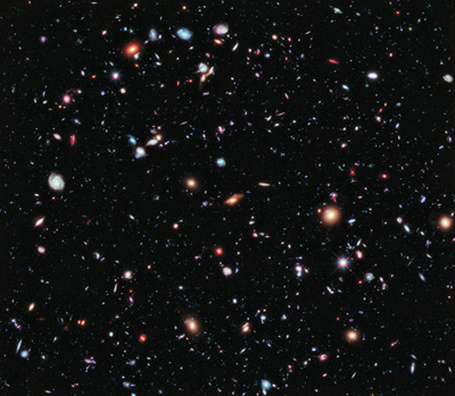In september 2012 astronomers assembled an improved portrait of mankind's deepest-ever view of the universe. Called the eXtreme Deep Field, or XDF, the photo was assembled by combining 10 years of NASA Hubble Space Telescope photographs taken of a patch of sky at the center of the original Hubble Ultra Deep Field. The XDF is a small fraction of the angular diameter of the full Moon. The Hubble Ultra Deep Field is an image of a small area of space in the constellation Fornax, created using Hubble Space Telescope data from 2003 and 2004.
By collecting faint light over many hours of observation, it revealed thousands of galaxies, both nearby and very distant, making it the deepest image of the universe ever taken at that time. The full-color XDF image (which you can download here) reaches much fainter galaxies and includes very deep exposures in red light from Hubble's infrared camera, enabling new studies of the earliest galaxies in the universe. The XDF contains about 5,500 galaxies even within its smaller field of view. The faintest galaxies are one ten-billionth the brightness of what the human eye can see.
Astronomers continue studying this area of sky with Hubble. Extensive ongoing observing programs, led by Harry Teplitz and Richard Ellis at the California Institute of Technology, will allow astronomers to study the deep-field galaxies with Hubble to even greater depths in ultraviolet and infrared light prior to the launch of JWST. These new results will provide even more extraordinary views of this region of the sky and will be shared with the public.
By collecting faint light over many hours of observation, it revealed thousands of galaxies, both nearby and very distant, making it the deepest image of the universe ever taken at that time. The full-color XDF image (which you can download here) reaches much fainter galaxies and includes very deep exposures in red light from Hubble's infrared camera, enabling new studies of the earliest galaxies in the universe. The XDF contains about 5,500 galaxies even within its smaller field of view. The faintest galaxies are one ten-billionth the brightness of what the human eye can see.
Astronomers continue studying this area of sky with Hubble. Extensive ongoing observing programs, led by Harry Teplitz and Richard Ellis at the California Institute of Technology, will allow astronomers to study the deep-field galaxies with Hubble to even greater depths in ultraviolet and infrared light prior to the launch of JWST. These new results will provide even more extraordinary views of this region of the sky and will be shared with the public.
~Ally

 RSS Feed
RSS Feed